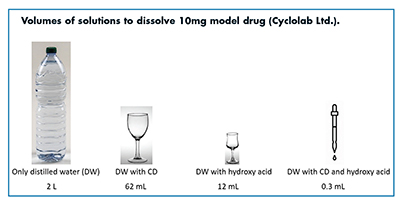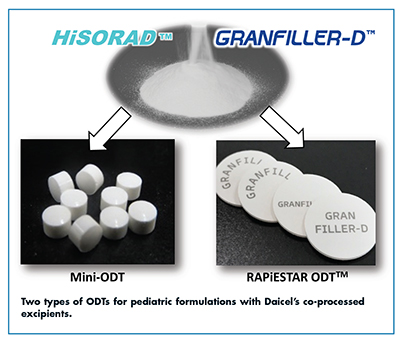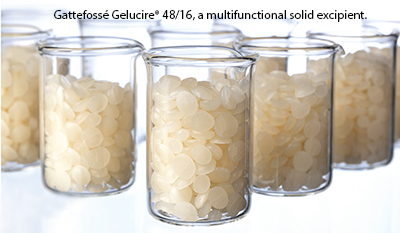Issue:April 2021
SPECIAL FEATURE - Excipients: Far From Inactive
Once defined as the inactive ingredient of a pharmaceutical drug, formulators are finding that excipients are anything but inactive, significantly impacting manufacturing, quality, efficacy, and delivery. Thus, industry experts predict the global pharmaceutical excipients market to reach upwards of $10 billion b7 2027.1 The pros expect these effecting excipients to play a role in generics and biosimilar development, and even COVID-19 as more companies are engaged in developing coronavirus vaccines.
As excipients become more “active,” research suggests that this may cause unintended reactions. A study conducted by the University of California San Francisco School of Pharmacy and the Novartis Institute for BioMedical Research portends that some excipients in common drugs may be biologically active and lead to unanticipated side effects. According to the scientists, excipients are generally accepted to be biologically inactive because they do not produce any obvious toxicity in animal studies, however a few studies have looked for more subtle effects of long-term exposure to these compounds and how they might interact in people who take multiple different medicines that include these ingredients.
In response, excipient manufacturers stand by the safety and quality of their drug ingredients. Dr. Yukiko Suganuma, Pharma Solutions, Daicel Corp., says: “Our co-processed excipients are composed of conventional ingredients that meet JP, USP-NF, and EP and are designed with reference to the Co-processed Excipient Guide for Pharmaceutical Excipients. Therefore, it seems that our co-processed excipients are satisfied in the view of quality and safety.”
And, Jasmine Musakhanian, Scientific and Marketing Director, Gattefossé USA, says: “In designing our existing and new excipients, Gattefossé always focuses on the excipient’s safety, biocompatibility, purity, and consistency of quality. More importantly we have spent decades accumulating extensive safety data in different animal models. The information is readily shared with the clients, in the form of Safety Overview dossiers and preclinical guides, with clear indication of maximum daily intake limits and precedence of use allowed by regulatory bodies. Our clients also have access to the market references, where our excipients are safely incorporated approved therapies to improve drug pharmacokinetics.”
In addition to Daicel Corp. and Gattéfosse, the companies highlighted in this annual report by Drug Development & Delivery assert that novel excipients – agglomerated, co-processed, and multifunctional – actively and safely affect formulation stability, solubility, and bioavailability as well as foster faster drug disintegration.
BENEO: Filler-Binder Excipient Improves OSDF Stability
Oral solid dosage forms (OSDFs) remain the preferred and most convenient delivery method for drugs and supplements. It is to be expected, perhaps, that some biosimilar drugs that are currently administered by injection could also be formulated into OSDFs. In that case, inert and compatible filler-binders are required. It seems that relatively new excipients such as agglomerated galenIQTM, which are chemically inert, could be suitable because of their compaction properties and surface structure, which promotes high content uniformity. BENEO’s pharma team is investigating the use of galenIQ in some new and emerging pharmaceutical technologies, including how it can be used to make 2mm orodispersible minitablets that disintegrate in the oral cavity within 30 seconds.

“Filler-binder excipients such as galenIQ can be used to improve the stability of OSDFs at low compression forces, which facilitates high-speed tableting and makes it more efficient,” says Dr. Michael Black, Head of Sales Pharma, BENEO. “Moreover, galenIQ is water-soluble and can be used in tablets without having to add a super-disintegrant. Using galenIQ could simplify both formulation development and production for pharmaceutical manufacturers.”
Dr. Black explains how BENEO works closely with customers during the formulation development phase and provides them with data and sample material to ensure the suitability of agglomerated galenIQ grades for processes such as continuous manufacturing and direct compression. As an example, one customer wanted to formulate a tablet containing two herbal extracts and a mineral. Each of these components had a different compaction profile. He says: “By using galenIQ 721, the customer was able to achieve good compaction, high content uniformity, and long-term stability.”
Cyclolab Ltd.: Evading Thermodynamic Constraints of Cyclodextrin-Drug Formulations
Applying cyclodextrins (CDs) in drug formulations helps form non-covalent, reversibly dissociating inclusion complexes with lipophilic drugs or their lipophilic moieties (via partial complexation). As a consequence, the aqueous solubility of the included substance may significantly increase. In solution, the constituents of the complex are in dynamic equilibrium, i.e. the free and bound species constantly undergo rapid association/dissociation governed by thermodynamic factors such as the association constant, temperature, and concentration of the host cyclodextrin and guest drug molecule. Determining these parameters is the key for successful classical complex composition design. Nevertheless, such factors often demonstrate limitation of CD complexing capacity, resulting in unacceptably high amounts of CD needed to encapsulate the therapeutic dose of some drugs.

“By evading the thermodynamic constraints of cyclodextrin-drug formulation design – by preparing supersaturated, but kinetically stabile compositions – even an apparently weak drug-CD interaction might be exploited to yield a practically applicable pharmaceutical product,” says Dr. István Puskás, a formulation expert at Cyclolab Ltd.
Two examples illustrate how to prepare such oversaturated solution in which the low rate of drug crystallization enables the administration of the composition within a reasonable time limit. First, hydroxypropyl betadex (HPBCD) is a peculiar CD soluble in ethanol. Ethanol-soluble guest drug molecules might be co-processed with HPBCD in their common ethanolic solution. By exhausting removal of the solvent, a glassy, amorphous coevaporate forms containing the drug in a solid HPBCD matrix in molecularly dispersed state. Upon contact with water, this coevaporate might dissolve and produce drug concentration over the thermodynamic equilibrium value. The chaotropic nature of multicomposite HPBCD hinders drug precipitation in aqueous solution. The oversaturated composition can then be stabilized by freeze drying, resulting in another amorphous composition that can be reconstituted prior to patient administration into a still oversaturated, but kinetically, stabile aqueous solution.
A second example is betadex sulfobutyl ether sodium (SBECD), as an ionic CD derivative often shows great pH-dependent variation on its solubilizing performance. If the chemical durability of the drug permits, complex formation can be performed at very low pH value (even exceeding the physiologically relevant range) to reach thermodynamic equilibrium at highly acidic medium. After successful complete dissolution, the pH might be raised to a physiologically acceptable pH range, resulting in an oversaturated solution having a composition that could not be spontaneously attained without this pH excursion, ensuring kinetic stability of the composition.
Another strategy applicable for native alfa-, beta-, and gamma-CDs to cope with low stability constant interactions is offered by the application of a third component like a polymer or hydroxy acid. In these ternary systems, a new stability constant applies that might be significantly higher than that obtained for binary drug-CD compositions. The stability of the reconstituted ternary system may be of thermodynamic or kinetic nature, says Dr. Puskás.
Daicel: Two ODT Formulations Offer Strength & Fast Disintegration
The number of available pediatric formulations are limited. Orally disintegrating tablets (ODTs) that disintegrate in the oral cavity within 30 seconds are a preferred choice for children, however even rapid disintegration of conventional ODTs is not necessarily enough for pediatric use. Daicel Corp. offers two types of ODTs for pediatric formulations by direct compression process using co-processed excipients.
One formulation is a mini-ODT. These miniaturized tablets are approximately 2 to 4mm in diameter and are considered to provide improved acceptability by children, says Dr. Yukiko Suganuma, Pharma Solutions, Daicel Corp. Moreover, by adjusting the number of tablets, the dose can be controlled according to weight and age of pediatric patients.

Mini-ODTs can be produced using DC co-processed excipients such as GRANFILLER-DTM or HiSORADTM without any special preprocessing. A 2018 study revealed that tablet weight of the mini-ODTs with GRANFILLER-D or HiSORAD was uniform and disintegration time of <3 seconds was achieved. They also exhibited sufficient hardness and friability for any mini-tablet measuring devices.
The other formulation is an ultra-fast disintegrating tablet, RAPiESTARTM ODT. RAPiESTAR ODT is approximately 14mm in diameter and ≤1mm thick. Its large surface allows rapid disintegration; a placebo tablet disintegrated in less than 5 seconds. Unlike other commercially available ultra-fast disintegrating tablets using lyophilization technologies, RAPiESTAR ODT can be produced by DC with GRANFILLER-D, explains Dr. Suganuma. “Although thin tablets are typically fragile in response to external impact,
RAPiESTAR ODT with GRANFILLER-D had practical strength that exceeded expectations. This thin tablet with enough strength is derived from the unique mechanical property of GRANFILLER-D.”
RAPiESTAR ODT is applicable to a variety of APIs. A feasibility study of RAPiESTAR ODT for commercial launch is currently in progress. “Thus, mini ODTs and RAPiESTAR ODTs prepared using GRANFILLER-D or HiSORAD disintegrate in several seconds, indicating excellent disintegratability far beyond that of conventional ODTs,” says Dr. Suganuma. “These tablets provide not only the advantages of ODTs, such as safety, convenience, and reliability, but also the special shape considered for suitability to children taking medications.”
Gattefossé: Lipid Excipients as Delivery Systems that Enhance Solubility & Bioavailability
Gelucire® series by Gattefossé are multifunctional excipients for solid self-emulsifying drug delivery systems (SEDDS) and low-temperature melt extrusion.
Given the low oral bioavailability and complex nature of the emerging chemical entities, there is a need for excipients that act as drug delivery systems on their own, simultaneously addressing the drug solubility, dissolution rate, and eventual absorption. This is possible with self-emulsifying liquid as well as solid lipid excipients.

For example, Gattefossé’s Gelucire 48/16 is a solid excipient that may be used in a variety of processes serving as solid drug delivery matrices in direct capsule filling, melt granulation, and preparation of solid amorphous dispersions using hot melt extrusion. The resulting powder or granules may be dry filled into capsules or compressed into tablets.
In the case of one poorly soluble drug, conventional formulation approaches were failing to produce the required drug release rate, explains Jasmine Musakhanian, Scientific and Marketing Director, Gattefossé USA. “Following a thorough solubility screening, our Technical Center of Excellence in Paramus, NJ, proposed a combination of two liquid excipients, including Labrasol®. The proposed formulations were able to release the entire dose within the first five minutes of dissolution.”
Shin-Etsu Chemical Co.: Multifunctional Excipients with High Binding Capability
With the advent of material science and particle engineering, various excipients with multifunctional properties for pharmaceutical applications have been introduced. Such excipients are Shin Etsu’s AQOAT (Hypromellose Acetate Succinate or Hydroxypropyl Methylcellulose Acetate Succinate (HPMCAS)) and L-HPC (Low substituted hydroxypropyl cellulose).
HPMCAS was first commercialized by Shin-Etsu Chemical Co., Ltd. in Japan in 1986 under the commercial name of Shin-Etsu AQOAT. It was originally developed as an enteric polymer for aqueous coating, explains Anisul Quadir, PhD, MBA, RPh, Technical Director, Pharmaceutical Excipient, Pharmaceutical Application Laboratory, SE Tylose USA, Inc., A Shin-Etsu Chemical Group Company.
“However, with recent advancements in solubilization techniques, such as spray drying and hot melt extrusion to prepare amorphous solid dispersion (ASD), HPMCAS became a polymeric carrier of choice for improving solubility and bioavailability of poorly water-soluble drugs,” he says.
Currently more than 25 marketed formulations consist of HPMCAS as a solid dispersion carrier. The distinct advantage of HPMCAS from other solid dispersion carriers is its ability to maintain the supersaturation of a drug for a long period of time, thus avoiding precipitation. For instance, it has been demonstrated that with HPMCAS, an extremely high apparent supersaturation has been achieved for almost 5 hours with poorly soluble APIs like Itraconazole and nifedipine. Additionally, having a higher glass transition temperature (Tg~1220C), HPMCAS makes a suitable carrier for a stable ASD formulation and inhibiting recrystallization of the drug until it has reached its shelf life, says Dr. Quadir. “The availability of optimum particle sizes (fine, medium as well as granular grade) and three different levels of acetyl/succinoyl substitution (low, medium and high) for HPMCAS gives more flexibility to the formulation scientist. The recently introduced mid- particle size grade of HPMCAS (70-300μm) helps to overcome the challenges of particle segregation and ensures consistent content uniformity in HME application.”
L-HPC is another multifunctional excipient with high binding capability and fast disintegration abilities. Different grades of L-HPC based on morphology, particle size, and % hydroxypropyl substitution have been introduced. Depending on the physical and chemical substitution, L-HPC can be used in both wet (LH-21) and in direct compression (NBD-021). However, smaller particle and higher compressibility grade would be better for dry granulation such as roller compaction. Therefore, LH-31 (and NBD grades) would be recommended for dry granulation says Dr. Quadir..
In a recent study, it was found that compressibility and compactibility of L-HPC is equivalent to a commonly used diluent like microcrystalline cellulose; water absorption and swelling capability is higher when compared to popular disintegrants like croscarmellose sodium and crospovidone, explains Dr. Quadir. “Higher compressibility, along with pH independent disintegration ability and no detectable peroxide content, makes L-HPC one of the most suitable and smart excipients for robust formulation development of solid dosage forms.”
Dr. Saurabh Mishra, a formulation scientist at the Shin-Etsu pharmaceutical application laboratory, says that L-HPC, in combination with PHARMACOAT 603 (HPMC, 3 m.Pas), could be ideal excipients to develop a robust platform for continuous manufacturing using twin screw wet granulation. Using a Quality by Design approach, using 5% LH-21 and 1% PHARMACOAT 603 achieved an immediate-release, robust formulation complying with critical quality attributes of a poorly flowable and compressible API like acetaminophen. “This could be attributed to the higher binding capability of L-HPC and lower viscosity of PHARMACOAT 603, which make it suitable for continuous manufacturing applications,” Dr. Mishra says.
Reference
- Pharmaceutical Excipients Market Forecast to 2027 – COVID-19 Impact and Global Analysis By Product; Functionality; Type of Formulation and Geography, ResearchandMarkets, March 19, 2021, https://www.businesswire.com/ news/home/20210319005275/en/Global-Pharmaceutical-Excipients-Market-Forecast-to-2027–COVID-19-Impact-and-Analysis–ResearchAndMarkets.com.
To view this issue and all back issues online, please visit www.drug-dev.com.
Total Page Views: 5523









